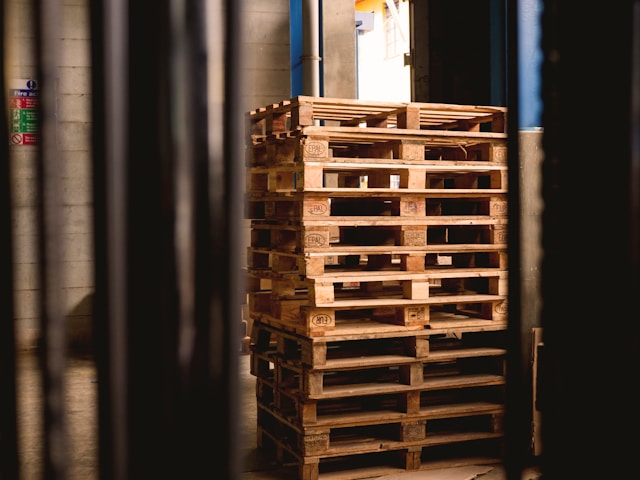Standards, Safety, and Environment: Wooden Pallet Regulations

Introduction
Wooden pallets are essential in the supply chain, facilitating the transport and storage of goods worldwide. However, their use is strictly regulated to ensure product safety, environmental protection, and compliance with international standards.
From export requirements such as ISPM 15 compliance to safety regulations and recycling obligations, businesses must adhere to strict standards to avoid fines, customs delays, or logistical complications.
What treatments are mandatory for wooden pallets? How can companies ensure compliance with European standards? What environmental obligations must be met?
This article covers the key regulations governing wooden pallets, including international standards, sustainable material management, and sector-specific requirements.
PART 1: Standards and Regulations for Wooden Pallets
Wooden pallets must meet several regulatory requirements to ensure safe and efficient logistics operations. These rules cover both sanitary treatments for international shipping and European safety standards, including different sizes of pallets. Failure to comply can lead to customs refusals, fines, and supply chain disruptions.
ISPM 15: A Mandatory Standard for Export
Any wooden pallet used for international shipping must comply with ISPM 15, a regulation designed to prevent the spread of pests and plant diseases. This standard requires pallets to undergo specific treatments that eliminate biological risks. Two methods are officially recognized: heat treatment and methyl bromide fumigation.
Heat treatment (HT) involves heating the wood to a minimum of 56°C for at least 30 minutes. This is the most widely used method due to its efficiency and low environmental impact. Methyl bromide fumigation (MB) involves exposing the wood to a toxic gas, but its use is increasingly restricted in Europe due to environmental concerns.
To be compliant, treated pallets must display a specific ISPM 15 marking, which includes the official logo, country code, manufacturer ID, and treatment type. Non-compliant pallets may be refused at customs, causing additional costs and logistical delays.
Safety Standards and Different Sizes of Pallets in Europe
Beyond sanitary treatments, wooden pallets must comply with manufacturing and safety standards to ensure durability and compatibility with storage and transport systems. In Europe, different sizes of pallets are standardized to optimize logistics.
The EUR/EPAL pallet, measuring 1200 x 800 mm, is the most widely used format. It is certified by the European Pallet Association (EPAL) and can support up to 4000 kg static load and 1500 kg dynamic load.
Another common format is the industrial pallet, measuring 1200 x 1000 mm, often used in retail and heavy industries for large, heavy goods. The Düsseldorfer pallet, at 800 x 600 mm, is preferred for automated logistics and distribution chains due to its compact size and ease of handling.
Standardized pallets improve safety, efficiency, and compatibility across supply chains. They reduce handling risks, ensure seamless transportation across logistics networks, and prevent additional costs due to pallet mismatches or refusals.
Non-compliance with these size and safety regulations can lead to damaged goods, increased storage costs, and supply chain inefficiencies. Choosing certified pallets ensures logistical fluidity and compliance with industry standards.
Wooden pallet regulations go beyond sanitary and sizing standards. Businesses must also comply with environmental obligations and industry-specific requirements, which will be explored in the next section.

PART 2: Environmental Regulations and Industry-Specific Requirements
Wooden pallets are increasingly subject to environmental regulations aimed at reducing waste and promoting sustainable use. Some industries, such as food, pharmaceuticals, and chemicals, impose stricter rules due to product safety concerns.
Environmental Obligations for Wooden Pallets
To minimize industrial waste, European regulations encourage pallet recycling and reuse. The EU Waste Framework Directive (2008/98/EC) requires companies to incorporate wooden pallets into recycling or reuse programs.
In France, the Extended Producer Responsibility (EPR) law applies to wooden pallets. This regulation mandates companies to manage pallet end-of-life, ensuring they are either recycled or processed by specialized waste management firms. Non-compliance can result in financial penalties and increased waste disposal costs.
Recycling and reusing wooden pallets benefit companies in multiple ways. It reduces environmental impact by limiting the consumption of new wood and lowers operational costs by extending pallet lifespan. Some logistics providers offer pallet recovery, repair, and resale services, creating a circular economy for sustainable supply chains.
Industry-Specific Regulations for Wooden Pallets
Different industries impose specific regulations on wooden pallets depending on the nature of the goods being transported.
In the food and pharmaceutical sectors, hygiene regulations require the use of new or treated pallets to prevent contamination. In some cases, direct contact between goods and wooden pallets is prohibited, leading businesses to opt for plastic pallets or protective barriers.
The chemical industry requires pallets that are resistant to hazardous materials. Special regulations govern pallet strength and durability to prevent chemical leaks or reactions. Certain products require reinforced pallets that can withstand extreme temperatures and exposure to corrosive substances.
In e-commerce and retail, warehouse optimization demands specific pallet formats compatible with automation systems. Many businesses use lightweight pallets or customized solutions to optimize truck loads and reduce transportation costs.
As regulations evolve, businesses must stay updated to avoid fines, logistics disruptions, and compliance issues. By incorporating certified, reusable, and industry-specific pallets, companies can optimize their supply chains while reducing their environmental footprint.
Conclusion
Wooden pallet regulations cover safety, international trade compliance, and environmental sustainability. The ISPM 15 standard requires specific treatments for exported pallets to prevent pest contamination, while European safety standards define pallet size and load capacities to ensure compatibility across logistics networks.
Beyond these technical requirements, environmental regulations increasingly encourage companies to adopt recyclable and reusable pallets. The EU Waste Directive and national regulations like France’s EPR law mandate responsible pallet disposal to minimize waste.
Industry-specific rules further impact pallet usage, particularly in food, pharmaceuticals, and chemicals, where hygiene and safety standards impose stricter material and treatment requirements.
To comply with evolving regulations and improve logistics efficiency, businesses should invest in certified, durable, and environmentally friendly pallets. Adapting to these standards ensures smoother international shipping, cost reductions, and a more sustainable supply chain.
